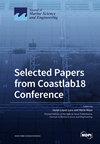基于海底电缆和拖曳流媒体数据的非重复时移地震监测研究
IF 2.8
3区 地球科学
Q1 ENGINEERING, MARINE
引用次数: 0
摘要
时移地震研究在监测气水界面隆起变化、振幅属性减弱以及采矿导致的气体分布方面发挥着重要作用。时移地震研究涉及不可重复数据,由于地震数据采集参数和地震几何参数的不同,数据集之间存在显著差异,因此在进行时移监测对比之前,必须进行一致的处理。本文介绍了基于海底电缆(OBC)和拖曳流媒体数据的两组非重复数据的时移地震监测研究。首先,对振幅、频率、小波和时差进行处理,以实现时移对比的一致性。其次,比较三种地震几何归一化模式,以优化适当的偏移、方位角和信噪比(SNR)。最后,在剔除断层面波后,提取两组数据同一位置的最大波谷振幅属性,利用比值法和差值法分析三种模式下的时移差异。研究结论表明:OBC 和拖曳流媒体数据在振幅、频率、小波、方位角、信噪比和时差方面都能达到一致;数据重建方法在偏移归一化、方位角和信噪比方面优于其他方法;振幅属性比值法的时移比较方法证明比差分法更有效。这项研究为今后利用非重复数据监测地下油气变化的时移地震研究奠定了可靠的基础。它还为碳捕获与封存(CCS)监测技术提供了方法论基础。本文章由计算机程序翻译,如有差异,请以英文原文为准。
Non-Repetitive Time-Shifted Seismic Monitoring Study Based on Ocean Bottom Cable and Towed Streamer Data
Time-shifted seismic research plays an important role in monitoring changes in the gas-water interface uplift, the weakening of amplitude attributes, and gas distribution due to mining. When time-shifted seismic research involves non-repeatable data with significant differences between data sets due to variations in seismic data acquisition parameters and seismic geometries, it necessitates consistent processing before time-shifted monitoring comparisons. In this paper, a study of time-shifted seismic monitoring using two non-repetitive data sets based on the ocean bottom cable (OBC) and towed streamer data is presented. First, amplitude, frequency, wavelet, and time difference are processed to achieve consistency for time-shifted comparisons. Secondly, three modes of seismic geometry normalization are compared to optimize the appropriate offset, azimuth, and signal-to-noise ratio (SNR). Finally, after eliminating the fault surface wave, the maximum trough amplitude attribute is extracted for the same position in the two data sets to analyze time-shifted differences under the three modes using the ratio method and difference method. The conclusions show the following: the OBC and towed streamer data can achieve consistency in terms of amplitude, frequency, wavelet, azimuth, SNR, and time difference; the data reconstruction method outperforms other methods in normalizing offset, azimuth, and SNR; and the time-shifted comparison method of the amplitude attribute ratio method proves more effective than the difference method. This study offers a reliable foundation for future time-shifted seismic research with non-repetitive data to monitor changes in subsurface oil and gas. It also provides a methodological basis for carbon capture and storage (CCS) monitoring technology.
求助全文
通过发布文献求助,成功后即可免费获取论文全文。
去求助
来源期刊

Journal of Marine Science and Engineering
Engineering-Ocean Engineering
CiteScore
4.40
自引率
20.70%
发文量
1640
审稿时长
18.09 days
期刊介绍:
Journal of Marine Science and Engineering (JMSE; ISSN 2077-1312) is an international, peer-reviewed open access journal which provides an advanced forum for studies related to marine science and engineering. It publishes reviews, research papers and communications. Our aim is to encourage scientists to publish their experimental and theoretical results in as much detail as possible. There is no restriction on the length of the papers. The full experimental details must be provided so that the results can be reproduced. Electronic files and software regarding the full details of the calculation or experimental procedure, if unable to be published in a normal way, can be deposited as supplementary electronic material.
 求助内容:
求助内容: 应助结果提醒方式:
应助结果提醒方式:


